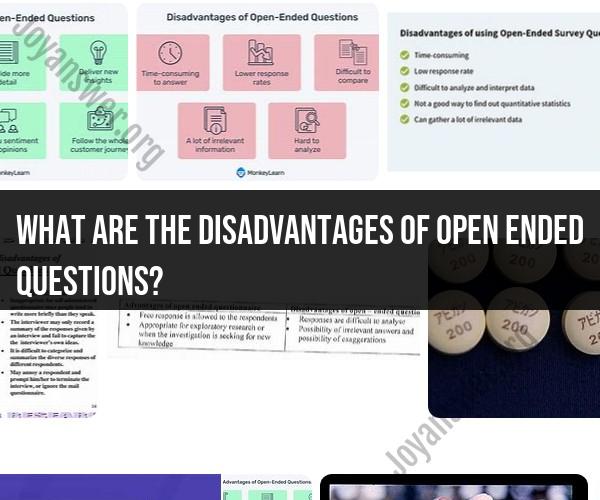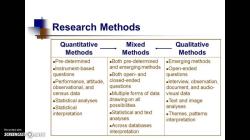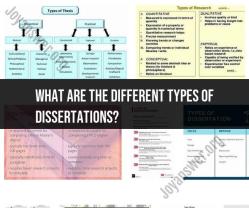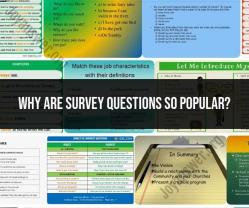What are the disadvantages of open ended questions?
While open-ended questions in surveys can provide valuable insights, they also have some disadvantages that you should be aware of:
Time-Consuming Analysis: Open-ended responses require manual analysis, which can be time-consuming and resource-intensive. Reading and categorizing responses from a large number of respondents can be a daunting task.
Inconsistent Responses: Respondents may provide inconsistent or incomplete answers. Some may write detailed responses, while others may offer brief or vague answers. This inconsistency can make it challenging to compare and analyze the data.
Bias in Interpretation: The interpretation of open-ended responses can be subjective. Different analysts may categorize or interpret the same responses differently, which can introduce bias into the analysis.
Limited Quantification: Open-ended questions produce qualitative data, which can be challenging to quantify. While you can code and categorize responses, it may not provide the same level of precision and quantifiability as closed-ended questions with predefined answer choices.
Reduced Response Rates: Respondents may be deterred by the prospect of having to write detailed responses. This can lead to lower response rates compared to surveys with only closed-ended questions.
Potential for Ambiguity: Open-ended questions can be susceptible to ambiguity and misinterpretation. Respondents may not fully understand the question or may interpret it differently, leading to responses that do not address the intended topic.
Response Bias: Some respondents may be hesitant to provide candid responses to open-ended questions, particularly when the topic is sensitive. They may self-censor or avoid answering, leading to response bias.
Data Overload: Open-ended questions can generate large volumes of data, making it challenging to manage and extract meaningful insights from the sheer amount of information.
Difficulty in Benchmarking: It can be difficult to benchmark or compare open-ended responses across different surveys or time periods due to the inherent subjectivity and variations in responses.
Loss of Structured Data: Closed-ended questions with predefined answer choices provide structured data that's easier to analyze quantitatively. Open-ended questions lack this structured data, making it harder to conduct statistical analysis or draw specific conclusions.
Despite these drawbacks, open-ended questions offer the advantage of capturing rich, qualitative data that can provide deeper insights and context. When used strategically and in combination with closed-ended questions, they can enhance the quality and comprehensiveness of survey results. Careful planning, analysis, and interpretation of open-ended responses can help mitigate some of these challenges.
The Limitations and Challenges of Open-Ended Questions
Open-ended questions have a number of limitations and challenges, including:
- Time-consuming to answer: Open-ended questions require respondents to type out their answers, which can be time-consuming, especially if the respondent is asked to provide a detailed response.
- Lower response rates: Respondents may be less likely to complete surveys that contain a lot of open-ended questions, as they can be more time-consuming and effort-intensive to complete.
- Difficult to compare: Open-ended responses can be difficult to compare to each other, as they can be of different lengths and cover different topics.
- Hard to analyze: Open-ended responses can be difficult to analyze, as they are qualitative in nature. This means that they cannot be easily quantified or statistically analyzed.
- Potential for biases: Open-ended responses can be biased by the respondent's own experiences, beliefs, and motivations.
Potential Biases in Responses to Open-Ended Questions
There are a number of potential biases that can occur in responses to open-ended questions, including:
- Social desirability bias: Respondents may be more likely to give answers that they believe are socially desirable, even if they do not accurately reflect their true opinions or beliefs.
- Confirmation bias: Respondents may be more likely to interpret the question in a way that confirms their existing beliefs.
- Anchoring bias: Respondents may be influenced by the wording of the question, and may give answers that are close to the examples or options that are provided.
- Recall bias: Respondents may have difficulty recalling their true opinions or beliefs, and may give answers that are based on their current mood or state of mind.
Analyzing and Interpreting Open-Ended Responses
There are a number of different ways to analyze and interpret open-ended responses. One common approach is to code the responses, which involves assigning categories to each response. This can be done manually or using software.
Once the responses have been coded, they can be analyzed using a variety of statistical methods, such as frequency analysis, crosstab analysis, and sentiment analysis.
It is important to note that there is no one-size-fits-all approach to analyzing and interpreting open-ended responses. The best approach will vary depending on the specific research question or goal.
Combining Open-Ended and Closed-Ended Questions
It is often beneficial to combine open-ended and closed-ended questions in surveys. This can help to overcome the limitations of each type of question.
For example, closed-ended questions can be used to collect quantitative data, such as demographics and preferences. Open-ended questions can then be used to collect qualitative data, such as opinions, beliefs, and experiences.
Combining open-ended and closed-ended questions can also help to improve the response rate of surveys, as respondents are more likely to complete a survey that contains a mix of different types of questions.
Strategies for Minimizing Disadvantages of Open-Ended Questions
There are a number of strategies that can be used to minimize the disadvantages of open-ended questions, including:
- Keep the number of open-ended questions to a minimum: Only use open-ended questions when they are necessary to collect the data that you need.
- Be clear and concise in your wording: Make sure that your open-ended questions are clear and easy to understand. Avoid using jargon or technical language.
- Provide enough space for respondents to write their answers: Don't crowd your open-ended questions. Provide enough space for respondents to write their answers in detail.
- Pilot test your survey: Pilot test your survey before you launch it to ensure that the open-ended questions are clear and easy to understand.
- Use a variety of analysis methods: Don't rely on a single analysis method to analyze your open-ended responses. Use a variety of methods to get a more complete and nuanced understanding of the data.
By following these strategies, you can minimize the disadvantages of open-ended questions and collect valuable data from your respondents.












